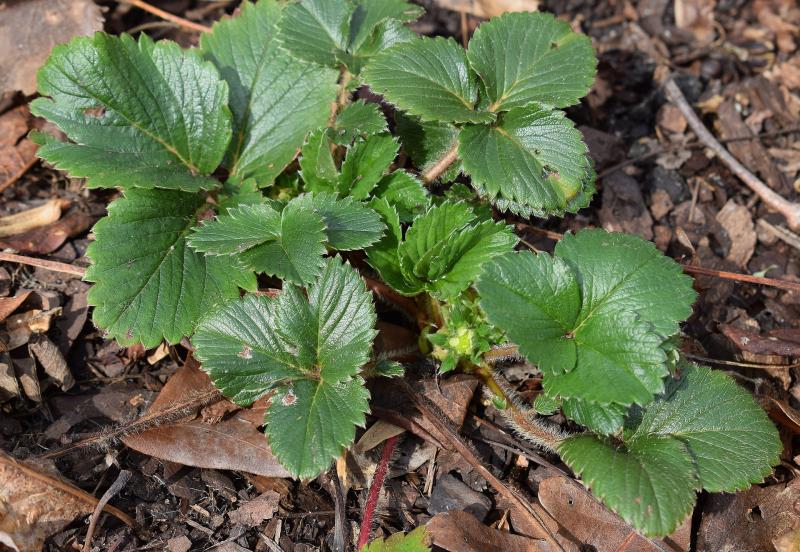Sarah Browning, Nebraska Extension Educator

Image of a young strawberry plant beginning to flower.
Strawberries are a popular, dependable fruit for home production. Three types of strawberries are grown in Nebraska: June bearing, everbearing and day neutral strawberries.
Which Strawberry to Plant?
June-bearing strawberries produce a single crop during late May and June. Plants come into full production the year after planting, and generally out-yield everbearing types. For most gardeners, June-bearing cultivars produce the largest fruit and greatest overall yield. Early fruiting cultivars include Earliglow and Early Red; mid-season Chandler, Honeoye, Jewel, Surecrop, Dunlap, Red Chief, Guardian; late season Robinson, Sparkle, Bounty.
Everbearing strawberries produce two crops- one in June, the second in late summer. High temperatures and moisture stress, along with mismanagement of the planting, greatly reduce the yield and quality of the fall strawberry crop for everbearing plants. In general, everbearing plants perform better in western Nebraska with its cooler night temperatures. Everbearing cultivars include Ogallala, Ft. Laramie.
Few people grow day neutral strawberries. Although day neutral plants have the potential to produce fruit throughout the entire growing season, they stop flower bud initiation when temperatures are above 85°F. Cultivars include Tristar and Tribute.
Generally, 25 plants of an early and 25 plants of a late June-bearing strawberry cultivar will provide sufficient berries for a family of four for dessert use, preserves and freezing.
Should I Buy Plants or Get Them From Friends?
Purchase good quality, vigorous, virus-free plant material from a reputable nursery. It generally is not advisable to transplant strawberries out of an old bed because disease problems can easily be introduced into the new planting.
Choosing and Preparing Your Site
Several important factors must be considered when choosing a location for your new strawberry planting.
- Choose a location with full sun and sandy loam, well-drained soil with a pH between 6 and 6.5 and an organic matter content around 2%. Strawberries will tolerate heavier soils, but not constantly wet roots. It is advisable to begin a soil-building program of organic matter incorporation the season before planting. A green manure crop can be grown and tilled in, or organic matter such as manure or compost can be added at a rate of 50 to 75 pounds per 1,000 square feet.
- Avoid planting strawberries in a site that previously has been planted with tomatoes, potatoes, peppers or eggplant, or back into a site in which strawberries have been grown in the last two years.
- Select an area that has few weed problems and take measures to eliminate the existing perennial weeds by using nonselective herbicides such as Roundup the season before planting strawberries. Because of the perennial nature of strawberry plants, there are few herbicides that selectively can control perennial weeds in a planting without injuring the strawberries. Cultivate areas that have been in grass sod the fall before planting strawberries.
- Avoid low lying areas in which cold air settles, creating frost pockets; the likelihood of frost injury is greater there. Because strawberries begin blooming in early spring and are subject to frost injury, be careful to select a site that has good air movement. A slope facing south warms up faster in the spring, stimulates earlier flowering, and increases the danger of frost injury. A north-facing slope that delays blooming until after the seasonal danger of frost has passed may be to your advantage.
- Irrigation is necessary during most seasons to produce good yields of strawberries, so select a site that has a good water source.
- Thoroughly incorporate 10 to 15 pounds of a complete fertilizer such as 10-10-10 or 12-12-12 per 1,000 square feet before planting.
Strawberry Bed Planting Systems
There are two main systems for training strawberry plantings, and your decision on which system to use will determine the spacing between rows, and between plants within the rows.
The matted row system, suited for June-bearing cultivars, is most commonly used by home gardeners. Set the plants 18 to 24 inches apart within the row and space the rows 36 to 48 inches apart. The plants are allowed to spread and fill an 18- to 24-inch wide mat.
The hill system for strawberry planting requires more intensive labor, but is the best system to use with everbearing and day-neutral cultivars, although it can also be used with the June-bearing types. Individual plants are set 18 inches apart within the row. Rows are spaced 18 inches apart with every third row left unplanted to serve as a walkway. All runners are removed as they develop, making the original plant the only one allowed to grow.
Planting
Before planting, remove all but two or three well-developed leaves per plant. Clip off any flower clusters that are visible to save the labor of removing them later in the field. Spread out the roots when planting and place the plant at a depth so that only the base of the crown is covered by the soil. If the crown is too high, the roots will be exposed and quickly will dry out. If the crown is too deep, it easily can be covered with soil and smothered. Gently firm the soil around the plant to prevent injury to the crown or tearing of the roots, and to avoid soil compaction.
Search Our Archive
Associated Video
Growing Strawberries
Nebraska Extension Educator Kathleen Cue talks about selecting, installing and caring for strawberries.